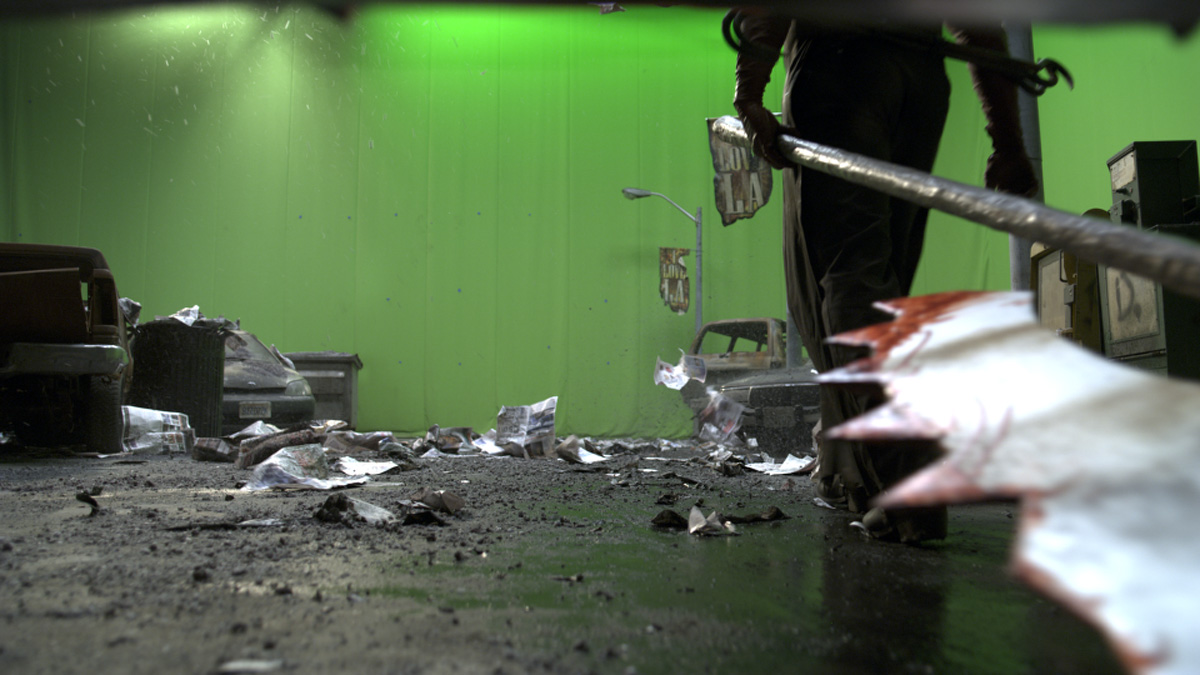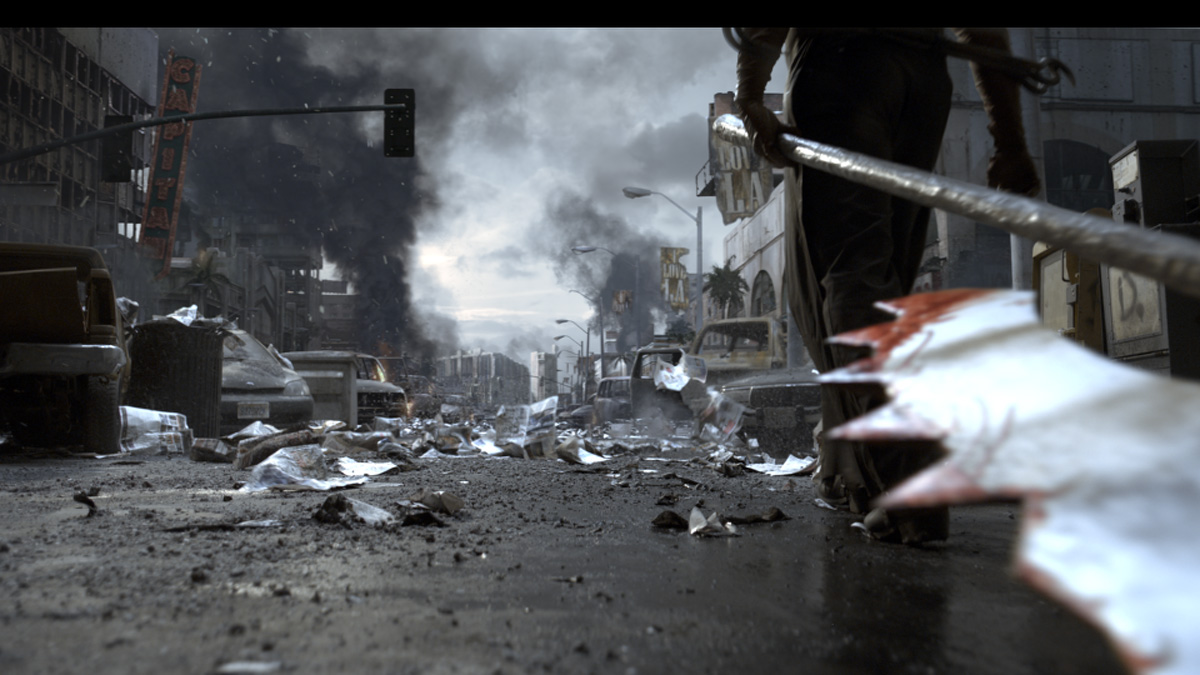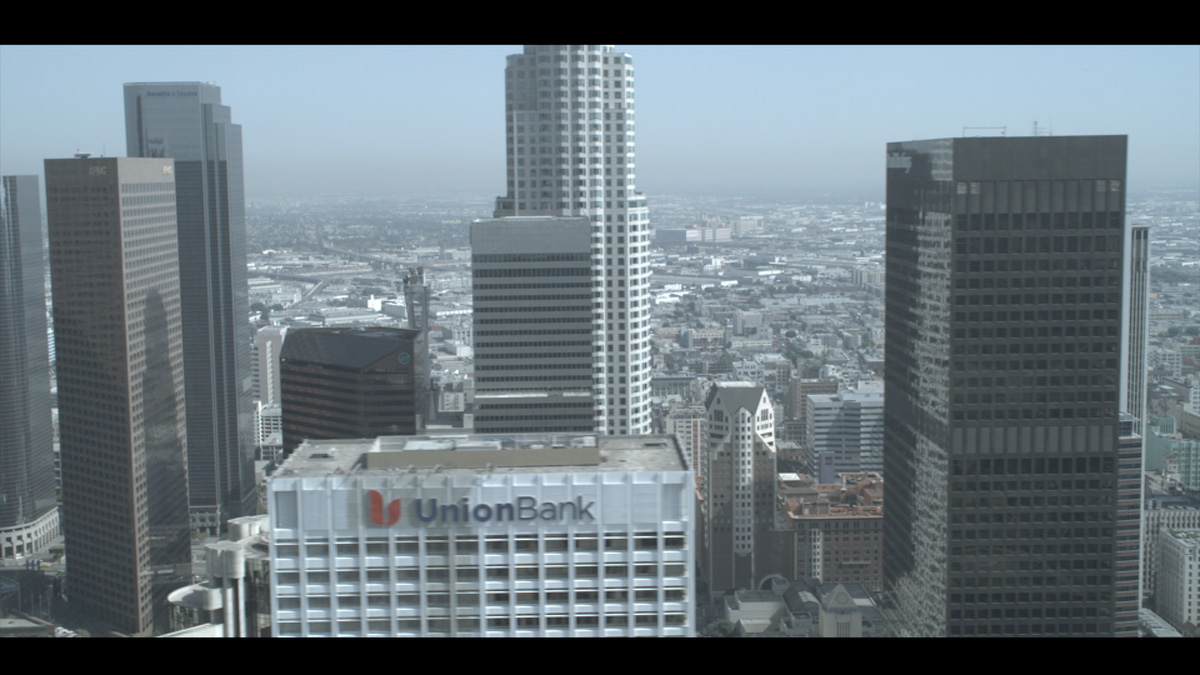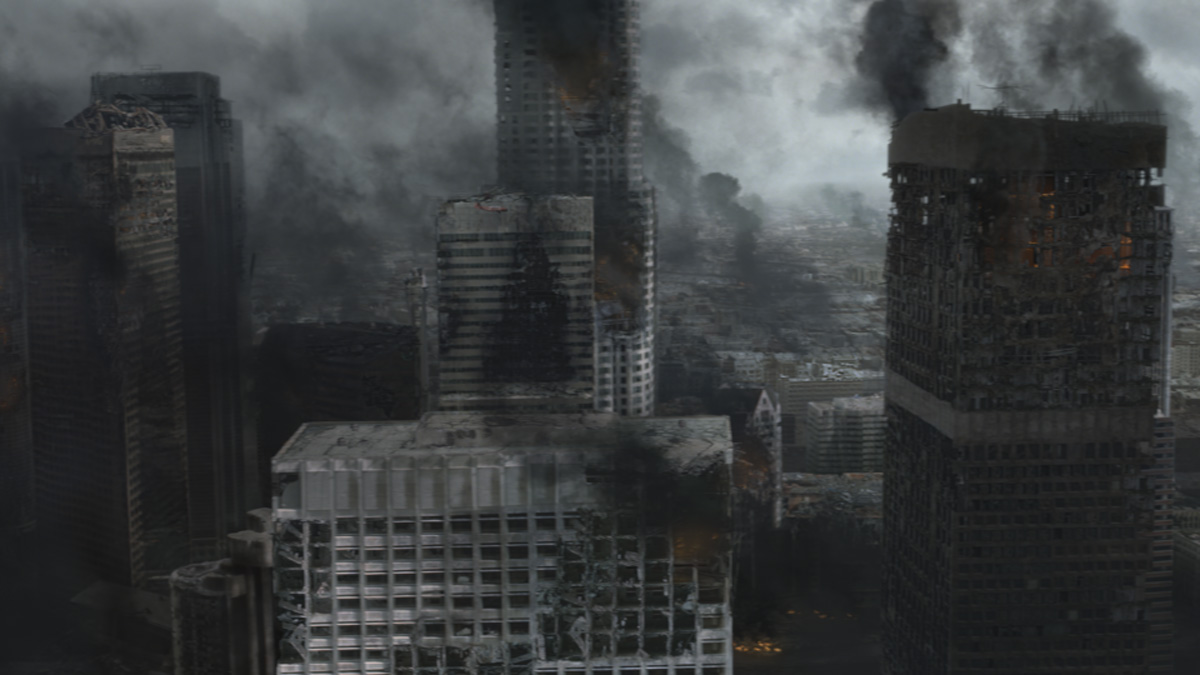After we have talked about the visual effects of Rodeo FX on Ara Khanikian gave me a new interview to talk about RESIDENT EVIL : AFTERLIFE 3D.
How was your collaboration with director Paul Anderson and the VFX supervisor of Mr X?
Our contact with the director was pretty minimal on this project since we were working directly with Mr X Toronto. We had a very close relationship with Dennis Berardi, the VFX supervisor of the project and owner / VFX supervisor at Mr X Toronto. Our approval and feedback process would be almost exclusively through weekly Cinesync sessions. On a couple of occasions, larger scale reviews were held at Mr X in Toronto where Rodeo FX’s VFX supervisor and co-owner, Sebastien Moreau would attend.
What are the sequences made by Rodeo FX?
Rodeo FX created the destroyed L.A. environment that we see throughout the movie. It was the main bulk of our workload on this project. It included the aerial shots of the plane, flying over landmarks such as the Hollywood sign and its arrival in a post-apocalyptic downtown L.A. We worked on all the shots on the prison rooftop. For these scenes, we delivered final shots and in some occasions, when it included digital zombies and CG extensions of the prison set, we would provide the rendered matte-paintings to Mr X who would deliver the final composite.
We also delivered a number of shots that required matte paintings and CG environment such as the arrival of the giant Axe-man zombie to the prison, we worked on transition shots where we’d start in front of the prison with a rioting group of zombies and travel down through the ground to reveal underground tunnel digging zombies. We also did some more gore-intensive shots were we’d add blood splatters, or brains in cracked-open skulls… everything we would expect to see in a RESIDENT EVIL movie!
 |
 |
Create a devastated city must be exciting for a matte painter. Can you explain how you proceed to create the views of Los Angeles?
Oh yeah, it’s definitely something very cool and fun to create!
We started off by creating a very low-rez layout of the city and its surroundings, using a lot of reference images and the use of Google maps. Once we identified where the physical position of the prison would be, we entered that position in Google maps and used its result to generate a 360 view of the city as it would be seen from the prison’s rooftop. Once that was done, we started the basic modeling of the skyscrapers and surrounding buildings. We used tons of hi-rez and low-rez images of L.A. to create the photo-realistic environment. The matte painters would start to work their magic and destroy everything that was visible. Every single building, every road, anything visible would get destroyed, breaking-of sides of buildings, adding burn marks and fires, aging all the roads and infrastructure, revealing metallic structures inside of buildings, etc etc… It had to feel like a post-apocalyptic world.
While this was being done, every single shot in our pipeline would go through our matchmoving and layout department. A FBX scene would get exported to the comp department where we’d start our work of placing all the fire and smoke plumes elements all around the city. For this show, we rented a studio and dispatched a team to shoot a lot of fire and smoke elements that got composited in all of our shots.
By using this pipeline, with an FBX asset, it assured us that all these elements that we would be adding in these shots would be accurate in “stereo space” and their continuity from shot to shot would be respected.
As layouts would get approved, we’d get work-in-progress passes from the matte painting and CG departments and render-out QTs. This allowed us to rapidly give feedback to all artists concerning the layout, stereo, matte painting, and comp work as the shots progressed to their final state.
What were your references?
We went through a lot of images and footage of burning buildings, warzones, and earthquakes to get a good feeling and real-world references of what a deserted burning downtown would look like. It was important to see and analyze how buildings burn and what’s left of them after years of war or catastrophic events and fire. Looking at natural catastrophes (earthquakes, floods, mudslides, etc, etc..) was also a good reference for what a post-disaster urban setting would look like without any human presence.
Can you explain the creation of the shot that shows the plane flying among the destroyed buildings?
For this shot, we started off with the principal photography plate, match-moved it and recreated it entirely in 3d. A lot of attention was given to accurately create the inner structures of these buildings because we knew that we would have to create big holes in the structure and break-off big chunks of these buildings. Hi-rez textures and images were used by the matte-painters to add a lot of detail and create the destructed versions of these very well-known buildings.
Since this shot needed a lot of depth, fine detail, and perspective shifts seen inside most of the building’s burning floors, while keeping everything logical in “stereo-space”, a hybrid technique was used to give as much freedom as possible to the matte painters to paint in a 2d environment while having access to all the tools and render out all the necessary passes for the compositing department. These buildings were pretty close-up and we had to see a lot of detail on and inside them. So, some parts of these buildings were textured in 3d and most of them were projected matte-paintings and we were still able to extract a lot of passes to accurately have control on lighting and compositing.
A lot of work was also done in comp to add all the plumes of smoke and all the fires in these buildings. A hi-rez model of the scene was imported in Nuke to help create all the interactive lighting that’s generated by these fires. One big challenge was to have these fires burning inside specific offices and spaces in the buildings and we had to avoid as much as possible rotoscoping everything. So, we used a Pcolor pass from XSI , which basically is an RGB image that’s a remap of the vectorial position of every pixel, it basically remaps the XYZ values of every pixel into RGB values. We built a custom tool in Nuke, that allowed us to easily and accurately extract all the mattes and depth information using this pass and it worked seamlessly in a stereoscopic context.
 |
 |
Have you animated the CG plane or was it provided by Mr X?
No, the plane was provided by Mr X. We provided them an XSI scene with our layout and they used it to animate the plane. Once the animation got approved, they sent us the renders and we comp’ed it in the shot.
Can you tell us about the challenge of stereoscopy? What does it change in the creation of matte-paintings?
Stereoscopy is always a challenging workflow even if most of the softwares have started proposing stereo-friendly tools. It’s always a bit more challenging to create shots that are as beautiful as possible and work seamlessly in stereo. There are so many techniques and approaches that work flawlessly for mono shots that just doesn’t work in stereo… we can’t cheat in stereo space, everything has to be physically accurate. Some simple things like adding haze or depth of field can be an easy thing to achieve in mono but can be a lot trickier to make it look good in stereo. A shot can be beautiful but if the stereo is uncomfortable, everybody will cringe and close their eyes!
It’s also a challenge for the matte paintings because a stereo layout becomes crucial to accurately project the paintings. The painting is still done as a mono element and is projected using a stereo rig in the 3d software.
Some of the other challenges was dealing with the fact that the movie was shot digitally with 3 different stereo rigs; there was a rig using the RED cameras for all the aerial shots, the Sony F35 was used for principal photography, and the Phantom for all the vary-speed shots. And, of course, all these rigs need to have different color profiles and have to seamlessly blend together. So, a lot of attention was given to the whole color pipeline and management for this project.
Nuke has a lot of great tools and feature for stereo work and it was an invaluable asset. We were also very happy to beta test the 2011 version of Flame that had a full stereoscopy workflow. It really made a huge difference
How have you designed and created the prison?
The prison was actually designed and created at Mr X.
Is there a shot that prevented you from sleeping?
No.. Not really. Some shots were a bit more challenging because of the stereo factor but with the good resources and enough time everything ends up looking great.
How many shots have you made?
We delivered 85 shots.
What was the size of your team?
We had a team of 40 artists on this project.
What did you keep from this experience?
This was a really fun project for all of us, it was a great project for all the matte painters because they got to destroy LA. TDs had the challenges of stereoscopy to deal with, and for the compositors, it was a lot of fun also because we had so many elements to play with… There was destruction, fire and smoke everywhere!
I was actually very eager to start this project because the last stereo project that I had worked on, we didn’t have any stereo tools… Everything was done manually. This time, we had softwares and tools designed specifically for stereo work and it made a huge difference!
What is your next project?
We’re presently finishing our work on SOURCE CODE, and starting on IMMORTALS.
A big thanks for your time.
// WANT TO KNOW MORE?
– Rodeo FX: Official website of Rodeo FX.
////
Rodeo FX – credits list
Visual Effects Supervisor
Sébastien Moreau
Visual Effects Producer
Tara Conley
Visual Effects Coordinator
Josiane O’Rourke
VFX Creative Lead
Mathieu Raynault
CG Supervisor
Louis Katz
Production Assistants
Lee-Ann Simard
Gabriel Roy
Geneviève Morin
Compositors
Ara Khanikian
Laurent Spillemaecker
Vincent Poitras
Philippe Thibault
Simon Devault
Nicolas Déziel
Christophe Chabot-Blanchet
Philippe Roberge
Joao Sita
Winston Lee
Matte Paintings
Frédéric St-Arnaud
Moika Sabourin
Stéphane Brisson
Ludovic Lochem
Éric Hamel
Marilyne Fleury
Robin Tremblay
Xin Zhou
3D Artists
Gabriel Beauvais
Jeremy Boissinot
Daniel Rhein
Fabrice Vienne
Matchmovers
Jean-François Morissette
Étienne Poulin-St-Laurent
Rotoscope Artists
Thomas Montminy Brodeur
Patrick David
Operations
Marilyn Bourcier
Antoine Gagné
Curtis Linstead
Jordan Soles
Benoit Touchette
© Vincent Frei – The Art of VFX – 2010




